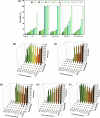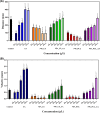Ecotoxicity evaluation of polymeric nanoparticles loaded with ascorbic acid for fish nutrition in aquaculture
- PMID: 34059056
- PMCID: PMC8166143
- DOI: 10.1186/s12951-021-00910-8
Ecotoxicity evaluation of polymeric nanoparticles loaded with ascorbic acid for fish nutrition in aquaculture
Abstract
Background: Ascorbic acid (AA) is a micronutrient essential for the mechanisms of reproduction, growth, and defense in fish. However, the biosynthesis of this micronutrient does not occur in fish, so it must be supplied with food. A difficulty is that plain AA is unstable, due to the effects of light, high temperature, and oxygen, among others. The use of nanoencapsulation may provide protection and preserve the physicochemical characteristics of AA for extended periods of time, decreasing losses due to environmental factors.
Method: This study evaluated the protective effect of nanoencapsulation in polymeric nanoparticles (chitosan and polycaprolactone) against AA degradation. Evaluation was made of the physicochemical stability of the nanoformulations over time, as well as the toxicological effects in zebrafish (Danio rerio), considering behavior, development, and enzymatic activity. For the statistical tests, ANOVA (two-way, significance of p < 0.05) was used.
Results: Both nanoparticle formulations showed high encapsulation efficiency and good physicochemical stability during 90 days. Chitosan (CS) and polycaprolactone (PCL) nanoparticles loaded with AA had mean diameters of 314 and 303 nm and polydispersity indexes of 0.36 and 0.28, respectively. Both nanosystems provided protection against degradation of AA exposed to an oxidizing agent, compared to plain AA. Total degradation of AA was observed after 7, 20, and 480 min for plain AA, the CS nanoparticle formulation, and the PCL nanoparticle formulation, respectively. For zebrafish larvae, the LC50 values were 330.7, 57.4, and 179.6 mg/L for plain AA, the CS nanoparticle formulation, and the PCL nanoparticle formulation, respectively. In toxicity assays using AA at a concentration of 50 mg/L, both types of nanoparticles loaded with AA showed lower toxicity towards the development of the zebrafish, compared to plain AA at the same concentration. Although decreased activity of the enzyme acetylcholinesterase (AChE) did not affect the swimming behavior of zebrafish larvae in the groups evaluated, it may have been associated with the observed morphometric changes, such as curvature of the tail.
Conclusions: This study showed that the use of nanosystems is promising for fish nutritional supplementation in aquaculture. In particular, PCL nanoparticles loaded with AA seemed to be most promising, due to higher protection against AA degradation, as well as lower toxicity to zebrafish, compared to the chitosan nanoparticles. The use of nanotechnology opens new perspectives for aquaculture, enabling the reduction of feed nutrient losses, leading to faster fish growth and improved sustainability of this activity.
Keywords: Chitosan nanoparticles; Ecotoxicity; Polycaprolactone nanoparticles; Vitamin; Zebrafish.
Conflict of interest statement
The authors declare that they have no competing interests.
Figures








Similar articles
-
Intravesical cationic nanoparticles of chitosan and polycaprolactone for the delivery of Mitomycin C to bladder tumors.Int J Pharm. 2009 Apr 17;371(1-2):170-6. doi: 10.1016/j.ijpharm.2008.12.015. Epub 2008 Dec 24. Int J Pharm. 2009. PMID: 19135514
-
Stability of chitosan nanoparticles for L-ascorbic acid during heat treatment in aqueous solution.J Agric Food Chem. 2008 Mar 26;56(6):1936-41. doi: 10.1021/jf073385e. Epub 2008 Feb 20. J Agric Food Chem. 2008. PMID: 18284198
-
Nanoencapsulation of ascorbic acid loaded in pluronic® F127 coated by chitosan-alginate polyelectrolyte complex and application of a direct quantification method to enhance its accuracy.Int J Biol Macromol. 2025 May;306(Pt 1):141372. doi: 10.1016/j.ijbiomac.2025.141372. Epub 2025 Feb 21. Int J Biol Macromol. 2025. PMID: 39988162
-
The role of chitosan on oral delivery of peptide-loaded nanoparticle formulation.J Drug Target. 2018 Aug;26(7):551-562. doi: 10.1080/1061186X.2017.1400552. Epub 2017 Dec 1. J Drug Target. 2018. PMID: 29095650 Review.
-
Polymer-based nanoparticles for oral insulin delivery: Revisited approaches.Biotechnol Adv. 2015 Nov 1;33(6 Pt 3):1342-54. doi: 10.1016/j.biotechadv.2015.02.010. Epub 2015 Feb 26. Biotechnol Adv. 2015. PMID: 25728065 Review.
Cited by
-
Moldable Plastics (Polycaprolactone) can be Acutely Toxic to Developing Zebrafish and Activate Nuclear Receptors in Mammalian Cells.ACS Biomater Sci Eng. 2024 Aug 12;10(8):5237-5251. doi: 10.1021/acsbiomaterials.4c00693. Epub 2024 Jul 9. ACS Biomater Sci Eng. 2024. PMID: 38981095 Free PMC article.
-
Dietary nanocomposite of vitamin C and vitamin E enhanced the performance of Nile tilapia.Sci Rep. 2024 Jul 8;14(1):15648. doi: 10.1038/s41598-024-65507-1. Sci Rep. 2024. PMID: 38977810 Free PMC article.
-
Revolutionizing Veterinary Medicine: The Role of Nanoparticles in Advancing Animal Health, Nutrition and Disease Management.Vet Med Sci. 2025 Sep;11(5):e70528. doi: 10.1002/vms3.70528. Vet Med Sci. 2025. PMID: 40747873 Free PMC article. Review.
-
Exogenous 2-keto-L-gulonic Acid Supplementation as a Novel Approach to Enhancing L-ascorbic Acid Biosynthesis in Zebrafish (Danio rerio).Animals (Basel). 2023 Aug 3;13(15):2502. doi: 10.3390/ani13152502. Animals (Basel). 2023. PMID: 37570309 Free PMC article.
-
A blend of chitosan-vitamin C and vitamin E nanoparticles robust the immunosuppressed- status in Nile tilapia treated with salt.BMC Vet Res. 2024 Jul 22;20(1):331. doi: 10.1186/s12917-024-04180-y. BMC Vet Res. 2024. PMID: 39039592 Free PMC article.
References
-
- Fisher B, Naidoo R, Guernier J, Johnson K, Mullins D, Robinson D, et al. Integrating fisheries and agricultural programs for food security. Agric Food Secur. 2017;6:1. doi: 10.1186/s40066-016-0078-0. - DOI
-
- El Basuini MF, Teiba II, Zaki MAA, Alabssawy AN, El-Hais AM, Gabr AA, et al. Assessing the effectiveness of CoQ10 dietary supplementation on growth performance, digestive enzymes, blood health, immune response, and oxidative-related genes expression of Nile tilapia (Oreochromis niloticus) Fish Shellfish Immunol. 2020;98:420–428. doi: 10.1016/j.fsi.2020.01.052. - DOI - PubMed
-
- Doan HV, Hoseinifar SH, Ringø E, Esteban MÁ, Dadar M, Dawood MAO, et al. Host-associated probiotics: a key factor in sustainable aquaculture. Rev Fish Sci Aquac. 2020;28:16–42. doi: 10.1080/23308249.2019.1643288. - DOI
-
- Shah BR, Mraz J. Advances in nanotechnology for sustainable aquaculture and fisheries. Rev Aquac. 2020;12:925–942. doi: 10.1111/raq.12356. - DOI
-
- FAO. FAO and the 17 Sustainable Development Goals [Internet]. 2015. http://www.fao.org/sustainable-development-goals/goals/goal-2/en/. Accessed 6 Oct 2020.
MeSH terms
Substances
Grants and funding
LinkOut - more resources
Full Text Sources
Medical

